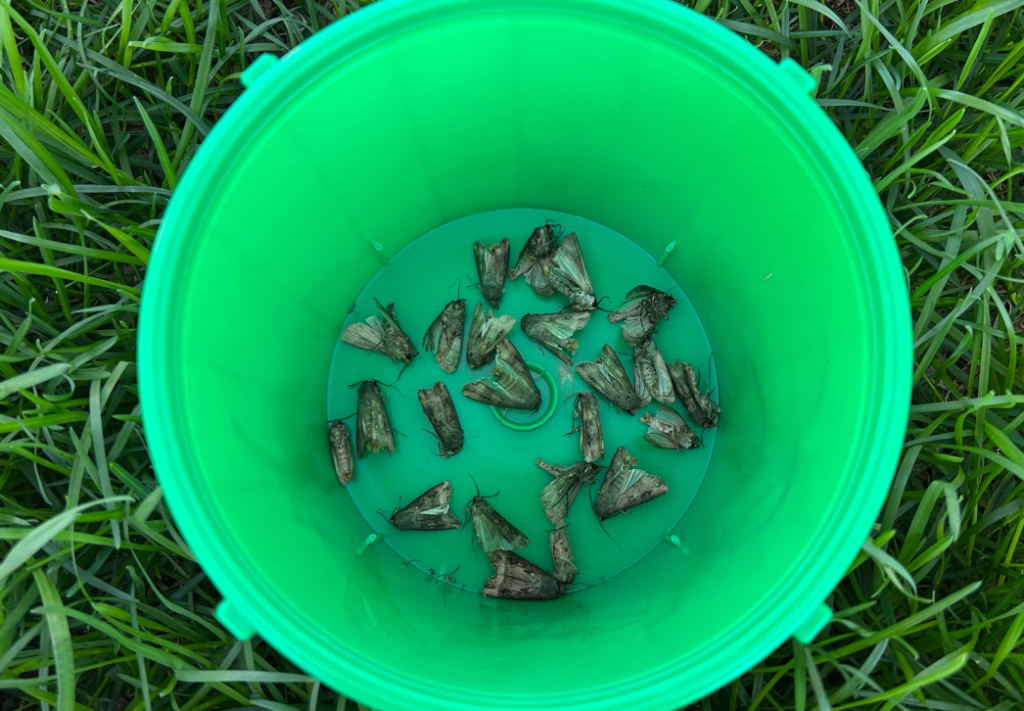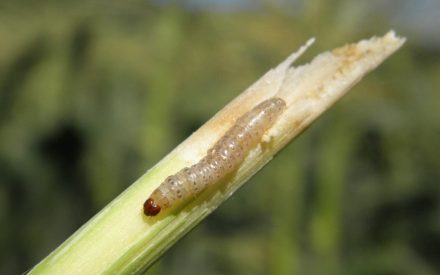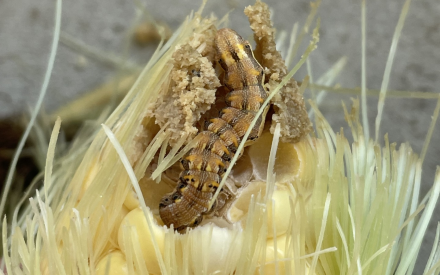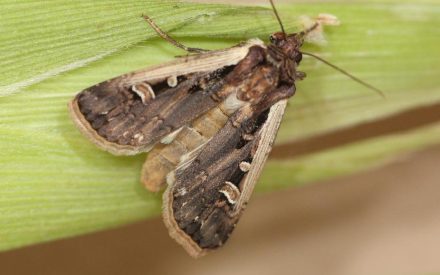What are black cutworms?
Black cutworm (Agrostis ipsilon) is the most common cutworm species affecting Wisconsin corn, although outbreaks are infrequent and difficult to predict. The larvae are particularly damaging to early-stage corn. Black cutworm (BCW) reduces stand counts and yield potential by cutting corn plants at the base or below ground. Adult moths do not damage crops.
What do black cutworms look like?
Egg: Black cutworm eggs are small, white and spherical. They are laid singly or in small groups of 10-30 per clutch on grasses and other vegetation (Figure 1), usually in areas of fields where there is high soil moisture. The eggs turn purple before hatching.

Larva: Black cutworm larvae vary in color from light gray to nearly all black. The body has a glossy sheen which has earned this species the name “greasy cutworm” (Figure 2-3). The head is dark brown. Larvae develop through six or seven instars and grow to a length of 1.5-inches.


Black cutworm larvae look similar to dingy cutworm larvae. The two cutworm species can be differentiated by the dark tubercles (wart-like nodules) along the body (Figure 4). Dingy cutworm tubercles are roughly the same size. On each body segment of the BCW larva, the tubercle closest to the head is smaller than the tubercle closest to the rear.

Pupa: Black cutworm pupae are found in the soil. Initially they are light brown, becoming darker prior to moth emergence (Figure 5).

Adult: The moths have a 1.25 to 2.0-inch wingspan (Figure 6). The forewings are dark brown to black with distinct black “dagger” markings. Look for the dagger two-thirds of the way down the outer edge of the forewing. This feature is diagnostic and makes BCW easy to recognize.

Life cycle and biology of black cutworms
Black cutworms overwinter as pupae in the soil across southern United States. The moths migrate to Wisconsin in the spring on storm fronts. The earliest moths usually appear in March or April and the migration peaks in late April or May. The Wisconsin Department of Agriculture, Trade and Consumer Protection (DATCP) tracks the timing of BCW arrival and moth flights in Wisconsin through its Black Cutworm Monitoring Network (Figure 7).

Female moths prefer to lay eggs in crop residue, weedy areas, or low, wet spots in fields. Green cover crops and corn planted after soybeans are also attractive egg-laying sites. The eggs are laid singly or in small groups and hatch in 5-10 days at average spring temperatures. Black cutworm larvae progress through six to seven instars (stages). Larval instars are identified by the width of the head capsule (Figure 8) rather than the length of the larva.

Black cutworm larvae feed at night and hide in the soil during the day. Small BCW larvae feed on weedy plant hosts and corn leaves. Fourth instar and larger larvae can cut corn plants below ground. Cutting stage larvae may take as long as 34 days to pupate at temperatures of 60°F, while only 12 days are required at temperatures of 75°F. Hot, dry weather and soils cause larvae to spend more time underground cutting stems. After developing through six or seven instars over the course of 4-5 weeks, fully-grown larvae burrow below ground and enter the non-feeding pupal stage. Adults emerge about two weeks later.
In Wisconsin, BCW has two or three generations per year depending on the time of spring moth arrival and summer temperatures. A single generation takes between 35-60 days to complete. The first generation of BCW larvae which is active in May and June causes the most damage to field corn.
What are the symptoms of black cutworm damage?
Small larvae (less than 0.5-inch-long) feed above ground on corn foliage and cause “window paning” or small pinholes. Feeding injury by small larvae is not consequential but signals the presence of BCW in the field and a potential for economic damage as the larvae mature.
Larger larvae (0.5 to 1.5 inches long) in the fourth instar and beyond feed on the stalk and are capable of cutting V1-V2 corn plants at or just below the soil surface (Figure 9). A single larva can cut up to five plants during its lifetime. Finding one cut plant signals to check for damage in surrounding rows (Figure 10). Corn plants may recover if the cutting occurs above the growing point.
When corn reaches the V4-V5 growth stages, it is usually too large for BCW larvae to cut. The larvae instead burrow into corn plants below ground. Burrowing can lead to wilting, stunting, discoloration, or plant death (symptoms described as “wilted whorl” or “dead heart”), if the growing point is damaged.


How do you scout for black cutworms?
Early detection of BCW infestation is imperative for reducing crop losses and maximizing control measures. Begin field scouting for signs of BCW feeding as soon as corn plants emerge. Damage is most likely to occur in late-planted corn with an abundance of grassy weeds, in fields with reduced tillage or no-till practices, or in fields subject to spring flooding. Since infestations are likely to be localized in fields, at least one sampling location should be in a margin or in a grassy low-lying area of the field.
Scout by walking a W-shaped pattern in the field. Count five sets of 50 consecutive plants (250 total plants) and record the number of damaged plants.
Ideally, attempt to collect two larvae to confirm identification and determine the instar (stage). Dig around damaged plants and check for larvae within the two inches of soil surrounding the base of the plant. Next, determine the instar by measuring the width of the head capsule. The instar indicates how long the BCW larva will continue to feed and cause damage in the field. For example, a sixth instar BCW will continue feeding for approximately 14 more days and could cut up to four plants in the one-leaf stage. A guide to determine BCW instar and potential damage in corn can be found in Pest Management in Wisconsin Field Crops (A3646) (p. 51).
Scout susceptible fields frequently. Mark off defined field areas and check for 2-3 weeks after corn emergence or until the V5 stage, at which point the plants are usually large enough to withstand BCW feeding. Monitor the plant stand, number of cut plants, and visible feeding damage.
What is the threshold for black cutworm treatment?
The treatment threshold for BCW is met if 2-5% of plants have been cut. This means that intervention is warranted if five to 12 of the 250 scouted plants are cut.
Treatment thresholds are not based on moth flights. DATCP’s Black Cutworm Monitoring Network provides updates on BCW moth migration and captures across the state. An intense capture of BCW is nine or more moths trapped in two nights. This information is used to determine the arrival of BCW in Wisconsin and to forecast the optimal time to scout for larvae. Moth flights should not be used to decide whether treatment is needed.
Integrated pest management (IPM) strategies for black cutworm
Cultural Control
Control of early-season weeds and timely termination of cover crops can reduce the attractiveness of fields to egg-laying female moths. Late cover crop termination or “planting green” can potentially create a green bridge where BCW larvae move to corn when the cover crop is terminated.
Biological Control
Predators such as insects, birds and mammals feed on BCW larvae and moths. Parasites, including flies, wasps, and nematodes, can also help control BCW larvae.
Chemical Control
Insecticides should not be applied as a “preventative approach” for BCW because of the difficulty of predicting outbreaks and the potential for pesticide overuse. Diligent field scouting and use of a rescue treatment (if necessary) is a more economical and reliable option.
Foliar insecticide applications can be effective if BCW damage exceeds the 2-5% threshold. Spot treatment should be considered if damage is isolated in the field. Refer to Pest Management in Wisconsin Field Crops (A3646) for insecticides labeled for cutworm control (p. 66-68).
If BCW damage is widespread and necessitates replanting, use a preemergence rescue treatment, such as a soil insecticide, to protect plants from BCW damage before, during, and after seedling emergence. Replanting decisions depend on the percentage of stand loss and the cost of seed. Refer to Pest Management in Wisconsin Field Crops (A3646) for soil insecticides labeled for application at planting time for cutworm control (p. 66-68). These products may effectively control light to moderate infestations but may not be effective against heavy infestations.
Planting transgenic Bt corn is another control method for BCW. The Bt corn expresses the soil bacterium Bacillus thuringiensis (Bt) toxin that is active against the pest.
Review “The Handy Bt Trait Table” in Pest Management in Wisconsin Field Crops (A3646) (p. 57-58) for a list of trait packages that are marketed to control BCW. If you plant transgenic Bt corn, be sure to plant the required refuge and follow recommendations to delay resistance.
Black cutworm response and management options
Monitor weather conditions and crop growth stage to determine optimal timing for insecticide applications, as needed. Efficacy of BCW insecticide treatments decrease in hot, dry weather because larvae spend more time underground and insecticide exposure is reduced.
Always apply insecticides according to label instructions and consider factors such as application method and rate.
Consider spot or border treatments if plant cutting is isolated within the field.
Environmental and ecological considerations for black cutworm treatment
Your field might be at higher risk for BCW damage if you:
- Plant corn into soybean, corn or wheat crop residue
- Plant corn after grass cover crops (e.g., cereal rye)
- Have weedy areas or low, wet spots
- Have late-planted corn fields
- Have cool or wet soil conditions
Timely termination of cover crops can reduce the attractiveness of fields for egg-laying. Late cover crop termination or “planting green” can potentially create a green bridge for BCW larvae to move to corn when the cover crop is terminated. Cool and wet soil conditions slow seedling growth which increases the risk of BCW damage.
Minimize pesticide use whenever possible to reduce potential impacts on non-target organisms, biological controls, and environmental health.
Implement IPM practices that promote biological diversity and ecosystem resilience.
References
Additional resources
Use information from DATCP’s Black Cutworm Monitoring Network to track the timing of BCW arrival in Wisconsin to optimally time field scouting.
Sign up for Insect Pest Text Alerts from the Bick Lab at UW-Madison to be alerted about BCW in your area.
For assistance with black cutworm management and other agricultural pest issues, contact your local agricultural extension office.
Last Updated: July 11, 2025
Reviewed by: Krista Hamilton (DATCP)
Featured cover image by Krista Hamilton.


 Managing Soybean Aphids in Wisconsin Soybean Fields
Managing Soybean Aphids in Wisconsin Soybean Fields Managing European Corn Borer in Wisconsin Corn Fields
Managing European Corn Borer in Wisconsin Corn Fields Managing Corn Earworm in Wisconsin Corn Fields
Managing Corn Earworm in Wisconsin Corn Fields Managing Western Bean Cutworms in Wisconsin Corn Fields
Managing Western Bean Cutworms in Wisconsin Corn Fields


